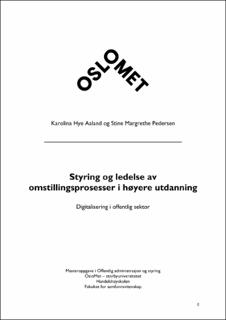| dc.description.abstract | OsloMet Metropolitan University is one of the largest institutions in Norwegian higher education. In the university and college sector, the has been an increasing attention to digital competence. Through a planned change process, professional employees at OsloMet should gradually adopt digital solutions. When the Covid-19 pandemic occurred, it put the university in an extraordinary crisis situation, which demanded the large organization to readjust immediately.
The theme for the thesis is precisely digitization as an institutional change at OsloMet Metropolitan University during the Covid-19 pandemic. Through an empirical analysis, we examine the university's role in the extraordinary digital development, and what tools the institution has available to anchor digitalization among academic staff. There are several theories about change management in the literature, and we have chosen to see the digital transformation of OsloMet in the light of Lewin's (1951) change model. The thesis is as follows: What opportunities and tools does the management at Norwegian universities have to manage and lead academic staff in a digital change process? Our thesis is based on an interview survey among 30 professional employees, supplemented by an analysis of public documents. The study is part of OsloMet's evaluation of the corona situation's effect on the digitization process at the university.
In our study, we find that the top management's conditional framework for managing the digital transformation at the university, are largely limited by the Universities and University Colleges Act. To manage the change process, top management has used organizational tools such as digitization strategy, hired a director of digitization, established administrative, professional and technical support functions, and not least symbolized the importance of digitization through active argumentation in public and internal processes. In this way, they have put digitalization up and forward on the university's agenda, which according to Lewin's change model is particularly important in any given change. The leader on the middle level has been close to the academic staff, and thus had the most important role in the implementation of digitization. To lead academic staff towards digitalization, they have used themselves as a tool through dialogue and follow-up. From the crisis, we see that digitalization can best be developed in an incremental and slow process, with time set aside for renewal, a supportive academic management and the participation of academic staff in the restructuring process.
| en_US |
